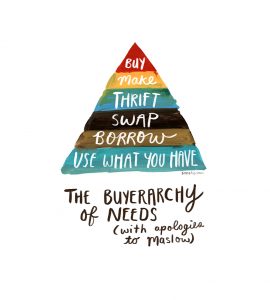By Sarah Irvin, DeGraaf Nature Center

We live in an age of consumption, as evident in our overflowing and expanding homes, garages, and external storage facilities.
Studies have shown this accumulation is not making us any happier and comes with a cost to both people and our environment. So, we need to think about the impact of our purchases. Sustainable consumption supports our economy, provides for the wellbeing of people worldwide, and protects the planet, according to a group called the Global Development Research Center
To live sustainably, we must first confront the notion of “need,” which is drastically different from a “want.” Once an actual need is realized, we can refer to Sarah Lazarovic’s “Buyerarchy of Needs,” which shows ways to meet a need with the least social and environmental impact. The idea is to explore the lowest impact options first, such as using what you have or perhaps borrowing, with buying something new only considered after all other options have been exhausted.
Another consideration is the lifespan impact of a purchase, beginning with the sourcing of materials, to manufacturing, use, and eventual disposal.
This holiday season is a great opportunity to start buying more sustainably. Consider buying gifts that are gentle on the planet, socially responsible, and meet a need of the person you’re buying for. When buying new, look to purchase from companies that are a Certified B Corporation. These are companies that have committed to considering impacts on workers, customers, suppliers, community and the environment. Or look to support other companies that prioritize employee’s well-being, minimize packaging, use renewable or recycled materials, or whose products can later be donated, recycled, or composted.
Other ideas for sustainable gifts move away from giving material objects. Scientific studies have found ways of getting more bang – or rather, happiness – for our buck.
One idea is to invest in experiences instead of material goods. Examples are tickets for an event or skill-learning class; membership to a museum, park or zoo, or being generous with time, such as offering help with a project or learning a hobby together. Gifting experiences also have the benefit of including a memory to revisit.
Another idea is to use money to benefit others instead of the individual you are gifting. Donate to a cause that a person cares about, use money to create and distribute care packages for disadvantaged persons, or purchase from organizations that use profits to benefit local or global causes.
Our ultimate goal should be to pursue joy and generosity regardless of physical belongings.
Following these guidelines will create more complex decisions, but nothing is more deserving of investment than products that minimally impact people and the Earth.
Sarah Irvin is an intern naturalist at the City of Hollands DeGraaf Nature Center.
Environmental Awareness/Action: Environmental education and integrating environmental practices into our planning will change negative outcomes of the past and improve our future.
Living Sustainably is a collection of community voices sharing updates about local sustainability initiatives. It is presented by the Holland-Hope College Sustainability Institute, a joint project of Hope College, the City of Holland and Holland Board of Public Works. Go to www.hope.edu/sustainability-institute for more information.